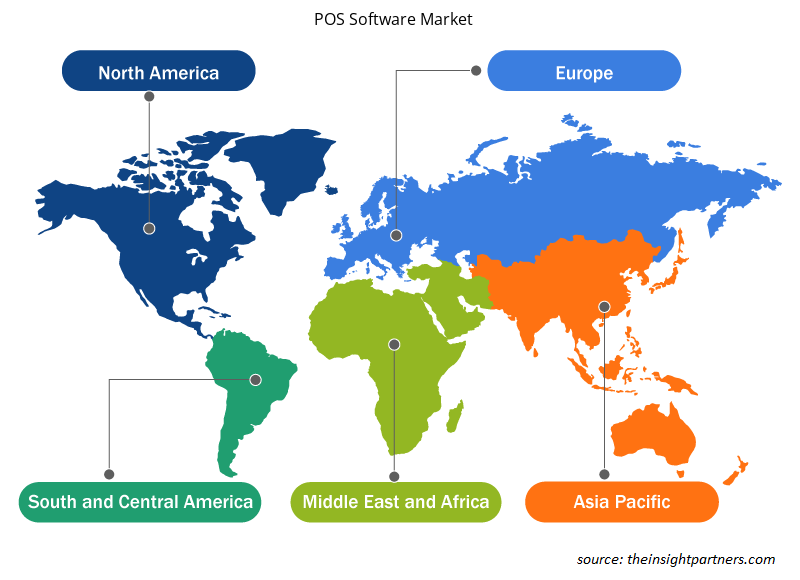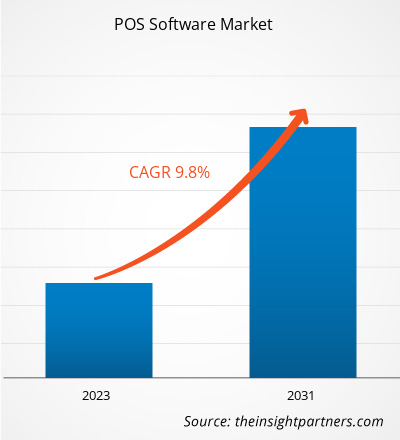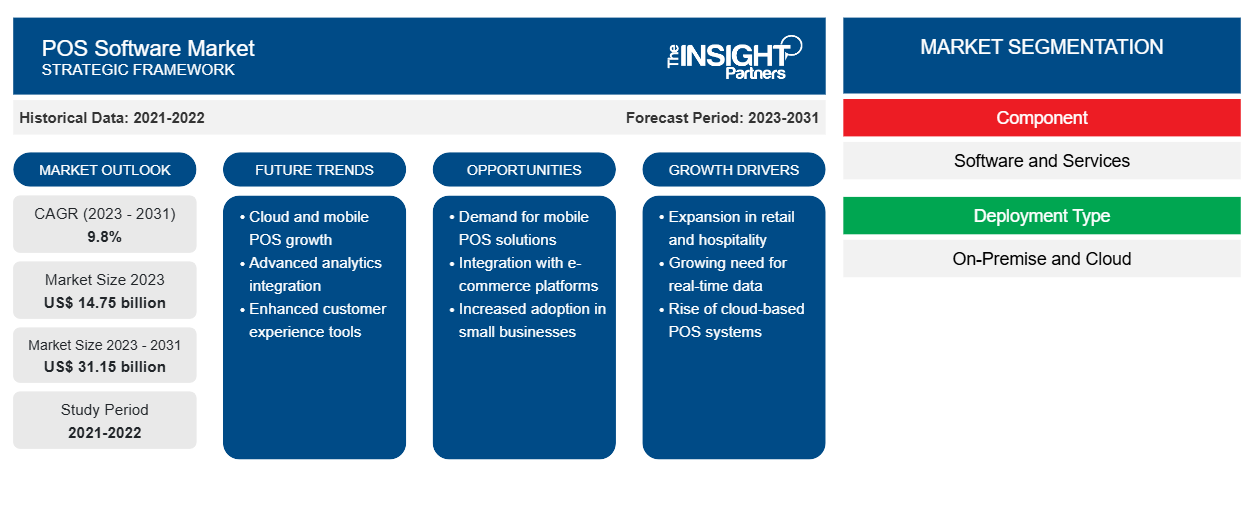Si prevede che la dimensione del mercato del software POS raggiungerà i 31,15 miliardi di dollari entro il 2031, rispetto ai 14,75 miliardi di dollari del 2023. Si prevede che il mercato registrerà un CAGR del 9,8% dal 2023 al 2031. È probabile che l'uso crescente dei servizi di cloud computing rimanga una tendenza chiave del mercato del software POS.
Analisi di mercato del software POS
La necessità di condurre transazioni senza contanti, tracciare i dati di vendita e inventario e sfruttare l'analisi per ottimizzare la strategia di vendita in catene di vendita al dettaglio, ristoranti, hotel, farmacie, officine e altri luoghi ha spinto la domanda di software per punti vendita (POS). Si prevede che l'utilizzo di software POS aumenterà in una varietà di settori a causa della crescente domanda di funzionalità avanzate tra cui gestione dei dati dei clienti, tracciamento dell'inventario, monitoraggio delle vendite, analisi della gestione dei dipendenti e reporting. Inoltre, la crescente domanda di software per punti vendita mobili basati su cloud potrebbe essere attribuita alla crescente accettazione di soluzioni basate su cloud.
Panoramica del mercato del software POS
Il software per punti vendita (POS) è un'applicazione specializzata che le aziende utilizzano per condurre transazioni presso il punto vendita, in genere in contesti di vendita al dettaglio. Tenendo traccia delle vendite, controllando l'inventario e gestendo i pagamenti, velocizza il processo di pagamento. Per garantire l'accuratezza, il software per punti vendita si interfaccia frequentemente con hardware quali scanner per codici a barre , registratori di cassa e lettori di carte. Inoltre, dispone di strumenti per gestire le informazioni dei clienti, creare report di vendita e valutare.
Personalizza questo report in base alle tue esigenze
Riceverai la personalizzazione gratuita di qualsiasi report, comprese parti di questo report, o analisi a livello nazionale, pacchetto dati Excel, oltre a usufruire di grandi offerte e sconti per start-up e università
-
Scopri le principali tendenze di mercato in questo rapporto.Questo campione GRATUITO includerà analisi di dati che spaziano dalle tendenze di mercato alle stime e alle previsioni.
Driver e opportunità del mercato del software POS
Crescita del settore dell'e-commerce
Con la crescente prevalenza dello shopping online e omnicanale, le aziende necessitano di software per punti vendita (POS) in grado di collegare senza soluzione di continuità i loro canali di vendita offline e online. Ciò determina la domanda di sistemi per punti vendita (POS) che includano funzioni come il controllo dell'inventario, l'evasione degli ordini e la gestione delle relazioni con i clienti (CRM), che sta alimentando la crescita del mercato dei software per POS.
Crescente domanda di Business Intelligence e Data Analytics
Il software Point-of-sale (POS) sta diventando uno strumento sempre più popolare utilizzato dalle aziende per raccogliere ed esaminare dati su vendite, comportamento dei clienti, inventario e performance dei dipendenti. Tecnologie di analisi e reporting sofisticate possono aiutare le aziende a prendere decisioni basate sui dati, aumentare la soddisfazione dei clienti e ridurre le procedure. Pertanto, si prevede che tali vantaggi del software POS stimoleranno la crescita del mercato nel periodo previsto.
Analisi della segmentazione del rapporto di mercato del software POS
I segmenti chiave che hanno contribuito alla derivazione dell'analisi di mercato del software POS sono i componenti (software e servizi); il tipo di distribuzione (on-premise e cloud); l'applicazione e l'utente finale
- In base ai componenti, il mercato del software POS è diviso in software e servizi. Il segmento software ha detenuto una quota di mercato maggiore nel 2023.
- In base al tipo di distribuzione, il mercato è diviso in on-premise e cloud. Il segmento on-premise ha detenuto una quota di mercato maggiore nel 2023.
- In base all'applicazione, il mercato è segmentato in monitoraggio dell'inventario, gestione degli acquisti, reporting delle vendite, coinvolgimento dei clienti e altri. Il segmento del monitoraggio dell'inventario ha detenuto una quota di mercato maggiore nel 2023.
- In base all'utente finale, il mercato è segmentato in vendita al dettaglio, ospitalità, media e intrattenimento, assistenza sanitaria e altri. Il segmento della vendita al dettaglio ha detenuto la quota maggiore del mercato nel 2023.
Analisi della quota di mercato del software POS per area geografica
L'ambito geografico del rapporto sul mercato del software POS è principalmente suddiviso in cinque regioni:Nord America, Asia Pacifico, Europa, Medio Oriente e Africa e Sud America/Sud e Centro America.
In termini di fatturato, il Nord America ha rappresentato la quota di mercato più grande del software POS. Il mercato in questa regione è segmentato in Stati Uniti, Canada e Messico. La regione ha un certo numero di noti produttori di software POS, così come un'elevata domanda di software POS integrato complesso. Inoltre, il settore della vendita al dettaglio sta assistendo a una crescita enorme nella regione, alimentando la crescita del mercato. Inoltre, si prevede che il settore sanitario statunitense crescerà al ritmo più rapido a causa della necessità di aggiornare le strutture ospedaliere relative ad assicurazione, pagamento e gestione dei pazienti.
Notizie di mercato e sviluppi recenti del software POS
Il mercato del software POS viene valutato raccogliendo dati qualitativi e quantitativi dopo la ricerca primaria e secondaria, che include importanti pubblicazioni aziendali, dati associativi e database. Di seguito è riportato un elenco degli sviluppi nel mercato dei disturbi del linguaggio e della parola e delle strategie:
- US Bank, leader del settore nei servizi di pagamento, ha annunciato il lancio di Avvance, una soluzione di prestito integrata e multicanale per punti vendita. Avvance offre alle aziende la possibilità di offrire finanziamenti ai consumatori durante il pagamento con una rapida richiesta e una decisione immediata. (Fonte: Elavon Inc., Comunicato stampa, 2023)
- NCR Corporation ha presentato NCR Aloha Cloud, una soluzione point of sale (POS) basata su cloud che offre funzionalità sufficientemente solide da essere immesse sul mercato con il marchio leader del settore Aloha. Aloha Cloud offre un'interfaccia utente (UI) rinnovata, il dispositivo portatile più piccolo sul mercato e un'elaborazione dei pagamenti senza interruzioni con finanziamento dei depositi il giorno successivo, dando agli operatori più tempo per concentrarsi sulla gestione del loro ristorante. (Comunicato stampa, 2022)
Approfondimenti regionali sul mercato del software POS
Le tendenze regionali e i fattori che influenzano il mercato del software POS durante il periodo di previsione sono stati ampiamente spiegati dagli analisti di Insight Partners. Questa sezione discute anche i segmenti del mercato del software POS e la geografia in Nord America, Europa, Asia Pacifico, Medio Oriente e Africa e America meridionale e centrale.

- Ottieni i dati specifici regionali per il mercato del software POS
Ambito del rapporto di mercato del software POS
| Attributo del report | Dettagli |
|---|---|
| Dimensioni del mercato nel 2023 | 14,75 miliardi di dollari USA |
| Dimensioni del mercato entro il 2031 | 31,15 miliardi di dollari USA |
| CAGR globale (2023-2031) | 9,8% |
| Dati storici | 2021-2022 |
| Periodo di previsione | 2023-2031 |
| Segmenti coperti |
Per componente
|
| Regioni e Paesi coperti |
America del Nord
|
| Leader di mercato e profili aziendali chiave |
|
Densità dei player del mercato del software POS: comprendere il suo impatto sulle dinamiche aziendali
Il mercato del software POS sta crescendo rapidamente, spinto dalla crescente domanda degli utenti finali dovuta a fattori quali l'evoluzione delle preferenze dei consumatori, i progressi tecnologici e una maggiore consapevolezza dei vantaggi del prodotto. Con l'aumento della domanda, le aziende stanno ampliando le loro offerte, innovando per soddisfare le esigenze dei consumatori e capitalizzando sulle tendenze emergenti, il che alimenta ulteriormente la crescita del mercato.
La densità degli operatori di mercato si riferisce alla distribuzione di aziende o società che operano in un particolare mercato o settore. Indica quanti concorrenti (operatori di mercato) sono presenti in un dato spazio di mercato in relazione alle sue dimensioni o al valore di mercato totale.
Le principali aziende che operano nel mercato del software POS sono:
- Infor Inc
- Intuit, Inc.
- Velocità della luce
- Società Oracle
- Rete di trifoglio, LLC
- Società NCR
Disclaimer : le aziende elencate sopra non sono classificate secondo un ordine particolare.

- Ottieni una panoramica dei principali attori del mercato dei software POS
Copertura e risultati del rapporto sul mercato del software POS
Il rapporto “POS Software Market Size and Forecast (2023–2031)” fornisce un’analisi dettagliata del mercato che copre le seguenti aree:
- Dimensioni del mercato e previsioni a livello globale, regionale e nazionale per tutti i segmenti di mercato chiave coperti dall'ambito
- Dinamiche di mercato come fattori trainanti, vincoli e opportunità chiave
- Principali tendenze future
- Analisi dettagliata delle cinque forze PEST/Porter e SWOT
- Analisi di mercato globale e regionale che copre le principali tendenze di mercato, i principali attori, le normative e gli sviluppi recenti del mercato
- Analisi del panorama industriale e della concorrenza che copre la concentrazione del mercato, l'analisi della mappa di calore, i principali attori e gli sviluppi recenti
- Profili aziendali dettagliati
- Analisi storica (2 anni), anno base, previsione (7 anni) con CAGR
- Analisi PEST e SWOT
- Valore/volume delle dimensioni del mercato - Globale, Regionale, Nazionale
- Industria e panorama competitivo
- Set di dati Excel
Report recenti
Rapporti correlati
Testimonianze
Motivo dell'acquisto
- Processo decisionale informato
- Comprensione delle dinamiche di mercato
- Analisi competitiva
- Analisi dei clienti
- Previsioni di mercato
- Mitigazione del rischio
- Pianificazione strategica
- Giustificazione degli investimenti
- Identificazione dei mercati emergenti
- Miglioramento delle strategie di marketing
- Aumento dell'efficienza operativa
- Allineamento alle tendenze normative























 Ottieni un campione gratuito per - Mercato del software POS
Ottieni un campione gratuito per - Mercato del software POS